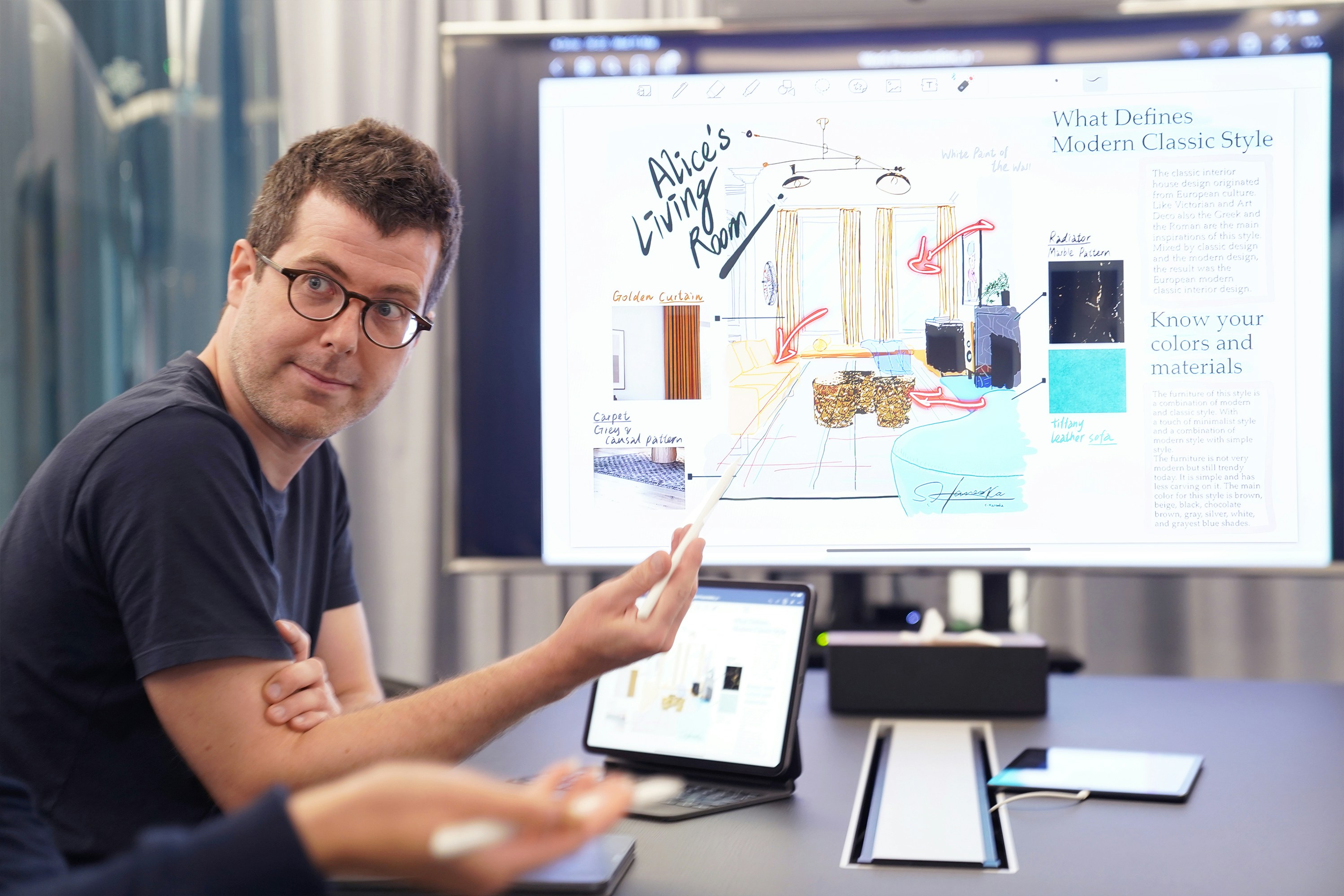Listen to this article
Study Skills
How to prepare for a presentation


Study Skills
How to prepare for a presentation


Study Skills
How to prepare for a presentation



Summary
Most people feel nervous about presentations. However, with the right techniques, you can support and improve your presentation skills to make them less intimidating.
Here are six simple strategies that will definitely help:
Use pictures
Have some notes
Remember to breathe
A bottle of water is your best friend
Speak slowly
Engage with your audience
Summary
Most people feel nervous about presentations. However, with the right techniques, you can support and improve your presentation skills to make them less intimidating.
Here are six simple strategies that will definitely help:
Use pictures
Have some notes
Remember to breathe
A bottle of water is your best friend
Speak slowly
Engage with your audience
Read this article
3m
A picture speaks a thousand words
Refrain from writing everything you will say on your slides - the audience will just read these instead of listening to you. Instead, have a few keywords on each slide and use images to create a visually exciting presentation.
If you're not great at design, find one image for each slide and use it alongside a few short bullet points - your audience will still appreciate that you've made an effort to make things more interesting for them.
To really win your audience over, you could supplement the presentation by creating a handout - they don't have to make notes and can just sit back and listen.
Have notes, but don't need them
Your slides are as much a prompt for you to remember what to talk about as for your audience, so if you have prepared fully and know your subject, you may not need any other notes or cue cards.
However, it’s easy to forget something in the moment, so it's always good to have some brief notes to hand, just in case. Make sure they are written in an easy way to find where you are, such as a card for each slide or a clearly titled list.
You may also have some very specific facts and figures you want to refer to that you must not get wrong, such as a definition, a source or some data points. Have these written down and read them out in the presentation - doing it that way means you'll get it right and emphasise to the audience that it's a key piece of information.
Remember to breathe
When the presentation starts, you may feel a rush of adrenaline from the unfamiliar situation. Expect this, and if it happens, you can control it by breathing deeply and holding your breath for a few seconds before exhaling. Repeat a few times until you feel calmer. If you need a few moments to prepare yourself, you can pretend to cue up your slides or silence your phone.
The secret prop: a bottle of water
It gives you something to hold in your hands if you struggle to know what to do with them. If you need a moment to gather your thoughts and refocus, take a sip of water. You then look like you are confidently pausing, perhaps to let your point sink in or to carefully consider your next word - it's all about conveying confidence.
Speak slowly
Really. Slow. It. Down.
Leave longer pauses between sentences.
Speaking slowly will help you to feel calm and make it easier for the audience to follow your presentation.
Plus, it can make it appear that you are considering what you are saying in the moment rather than rushing through your materials, creating an impression of confidence and control.
Engaging your audience
Scanning your audience or making sure you look at all parts of the room, can help engage your audience and make your presentation feel more conversational. Be careful not to only look at one person or to think you must make eye contact with everyone - go for broad sections of the audience, switching each time you make a new point or after referencing something in your slides.
Read this article
3m
A picture speaks a thousand words
Refrain from writing everything you will say on your slides - the audience will just read these instead of listening to you. Instead, have a few keywords on each slide and use images to create a visually exciting presentation.
If you're not great at design, find one image for each slide and use it alongside a few short bullet points - your audience will still appreciate that you've made an effort to make things more interesting for them.
To really win your audience over, you could supplement the presentation by creating a handout - they don't have to make notes and can just sit back and listen.
Have notes, but don't need them
Your slides are as much a prompt for you to remember what to talk about as for your audience, so if you have prepared fully and know your subject, you may not need any other notes or cue cards.
However, it’s easy to forget something in the moment, so it's always good to have some brief notes to hand, just in case. Make sure they are written in an easy way to find where you are, such as a card for each slide or a clearly titled list.
You may also have some very specific facts and figures you want to refer to that you must not get wrong, such as a definition, a source or some data points. Have these written down and read them out in the presentation - doing it that way means you'll get it right and emphasise to the audience that it's a key piece of information.
Remember to breathe
When the presentation starts, you may feel a rush of adrenaline from the unfamiliar situation. Expect this, and if it happens, you can control it by breathing deeply and holding your breath for a few seconds before exhaling. Repeat a few times until you feel calmer. If you need a few moments to prepare yourself, you can pretend to cue up your slides or silence your phone.
The secret prop: a bottle of water
It gives you something to hold in your hands if you struggle to know what to do with them. If you need a moment to gather your thoughts and refocus, take a sip of water. You then look like you are confidently pausing, perhaps to let your point sink in or to carefully consider your next word - it's all about conveying confidence.
Speak slowly
Really. Slow. It. Down.
Leave longer pauses between sentences.
Speaking slowly will help you to feel calm and make it easier for the audience to follow your presentation.
Plus, it can make it appear that you are considering what you are saying in the moment rather than rushing through your materials, creating an impression of confidence and control.
Engaging your audience
Scanning your audience or making sure you look at all parts of the room, can help engage your audience and make your presentation feel more conversational. Be careful not to only look at one person or to think you must make eye contact with everyone - go for broad sections of the audience, switching each time you make a new point or after referencing something in your slides.

Written by Tim Jones

Written by Tim Jones
0:00/1:34
Summary
Most people feel nervous about presentations. However, with the right techniques, you can support and improve your presentation skills to make them less intimidating.
Here are six simple strategies that will definitely help:
Use pictures
Have some notes
Remember to breathe
A bottle of water is your best friend
Speak slowly
Engage with your audience
Read this article
Most people feel nervous about presentations. However, with the right techniques, you can support and improve your presentation skills to make them less intimidating.
Here are six simple strategies that will definitely help:
Use pictures
Have some notes
Remember to breathe
A bottle of water is your best friend
Speak slowly
Engage with your audience
A picture speaks a thousand words
Refrain from writing everything you will say on your slides - the audience will just read these instead of listening to you. Instead, have a few keywords on each slide and use images to create a visually exciting presentation.
If you're not great at design, find one image for each slide and use it alongside a few short bullet points - your audience will still appreciate that you've made an effort to make things more interesting for them.
To really win your audience over, you could supplement the presentation by creating a handout - they don't have to make notes and can just sit back and listen.
Have notes, but don't need them
Your slides are as much a prompt for you to remember what to talk about as for your audience, so if you have prepared fully and know your subject, you may not need any other notes or cue cards.
However, it’s easy to forget something in the moment, so it's always good to have some brief notes to hand, just in case. Make sure they are written in an easy way to find where you are, such as a card for each slide or a clearly titled list.
You may also have some very specific facts and figures you want to refer to that you must not get wrong, such as a definition, a source or some data points. Have these written down and read them out in the presentation - doing it that way means you'll get it right and emphasise to the audience that it's a key piece of information.
Remember to breathe
When the presentation starts, you may feel a rush of adrenaline from the unfamiliar situation. Expect this, and if it happens, you can control it by breathing deeply and holding your breath for a few seconds before exhaling. Repeat a few times until you feel calmer. If you need a few moments to prepare yourself, you can pretend to cue up your slides or silence your phone.
The secret prop: a bottle of water
It gives you something to hold in your hands if you struggle to know what to do with them. If you need a moment to gather your thoughts and refocus, take a sip of water. You then look like you are confidently pausing, perhaps to let your point sink in or to carefully consider your next word - it's all about conveying confidence.
Speak slowly
Really. Slow. It. Down.
Leave longer pauses between sentences.
Speaking slowly will help you to feel calm and make it easier for the audience to follow your presentation.
Plus, it can make it appear that you are considering what you are saying in the moment rather than rushing through your materials, creating an impression of confidence and control.
Engaging your audience
Scanning your audience or making sure you look at all parts of the room, can help engage your audience and make your presentation feel more conversational. Be careful not to only look at one person or to think you must make eye contact with everyone - go for broad sections of the audience, switching each time you make a new point or after referencing something in your slides.

Written by Tim Jones
Prior to co-founding Booost Education, Tim previously worked with neurodivergent and disabled students at various universities and trained as an assistive technology consultant with AbilityNet.

Written by Tim Jones
Prior to co-founding Booost Education, Tim previously worked with neurodivergent and disabled students at various universities and trained as an assistive technology consultant with AbilityNet.